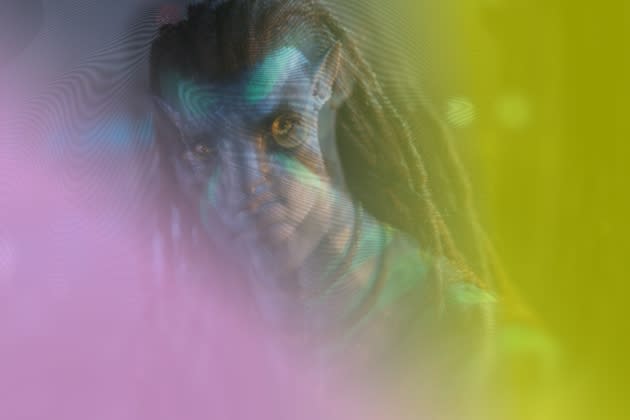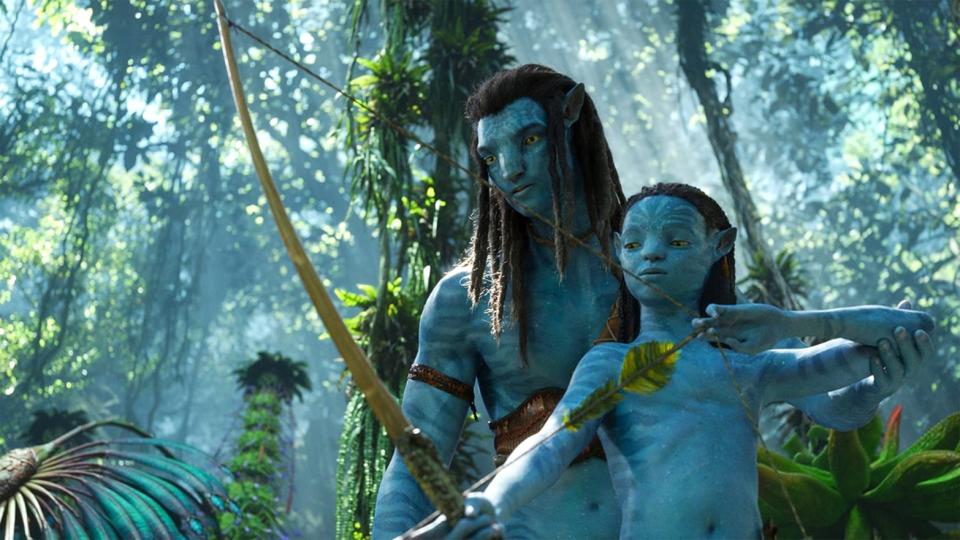What Is ‘Avatar: The Way of Water’ Like on Shrooms?
- Oops!Something went wrong.Please try again later.

I’m so high.
I overheard this as I walked through the concessions area at the AMC cinema in Universal CityWalk Hollywood, surprised that I wasn’t the person who said it. Which could only mean that I was also high, and the handful of psilocybin mushrooms I’d scarfed down in the bathroom at nearby Margaritaville some 30 minutes earlier had begun to take effect. Now I was part of a crowd that flowed toward the IMAX theater for an afternoon showing of Avatar: The Way of Water. My seat was in the fourth row.
More from Rolling Stone
'Titanic' Celebrates 25th Anniversary: Here's Where to Watch the Blockbuster Film Online
'Avatar: The Way of Water': Meet the Real-Life Na'vi Community

The absurdity of taking powerful hallucinogens for this movie is, of course, that you don’t really need them: the hypersaturated colors, immersive sound and bleeding-edge 3D visual effects are meant to act as drugs themselves, working your nervous system to produce god knows what. But dosing myself served a couple of aims. Fact is, I’ve never seen the original Avatar, having been “too cool” for it at the time, and figured tripping would help me roll with a story for which I had no frame of reference. If I had a meltdown and ran screaming out of the theater to regroup at Taco Bell, that would be a fitting atonement for snubbing this blockbuster franchise 13 years ago. But most of all, I wanted to see if my own inner journey would mesh with the vision before me, just as the Na’vi use their braids to jack into other creatures — or whatever the fuck is happening there.
Don’t explain it to me. I don’t care how anything on Pandora works, and I never will. The resource harvesting, the Earth Mother, the “avatar” concept itself… not important. Same goes for the plot, of which I refuse to attempt a summary. I could have used less plot, to be honest. While I’m probably in the minority of those who could happily sit through three-plus hours of a $350 million screen-saver, I’m sure I wasn’t the only one with a gnawing sense of unease about where The Way of Water was leading. The funniest part of the movie, it has to be said, was when I noticed the guy next to me looking at his phone.
And yet: “Imagine betting against James Cameron.” So goes the current maxim of Film Twitter, where a distaste for the clichés of popcorn spectacle is overwritten only if the spectacle is done right. Whereas the tastemakers can dismiss Marvel fare as muddy, algorithmic schlock, Cameron is the master craftsman who builds a world you can’t refuse. It was perhaps an hour into this one that I made the twin mistakes of underestimating both him and the shrooms. I ate some more.
As any seasoned drug user knows, “This stuff ain’t shit” leads inexorably to “What have I done?” I sealed my fate during a relatively chill stretch of the story, when Jake Sully’s forest-dwelling family is on the run from the bad guys and trying to adjust to the ways of a reef-dwelling Na’vi clan that has taken them in as refugees. Jake’s disaffected teen son befriends a lonely tulkun, a whale analogue that more closely resembles a giant sea slug. The vibe was very ’90s Trapper Keeper, or blacklight poster. Nothing could hurt me.
That illusion was shattered as the villains, Na’vi bodies imbued with the memories of dead U.S. Marines, allied with a crew of human whalers from New Zealand (?) to hunt the tulkun in such barbaric fashion as to draw Sully out of hiding. After basking in the serene oceanic biosphere, I saw it invaded by rapacious machines, every type of souped-up boat and submersible Cameron had engineered since 2009. The two sides began to clash in a monumental battle, with flying creatures swarming at people in mech suits, the sea polluted with blood and oil, and me — my body now thrumming with genuine fear — melting into my seat. It was too late to escape now, and I surrendered to a scale of events that dwarfed reality.
It was only much later, somewhat recovered, that I could analyze that fugue state. When my sainted girlfriend Mads picked me up at the mall, all I could tell her was, “James Cameron isn’t human.” What does that mean, she asked. I suppose I was struggling to say that after a certain point, there was no personhood left to the information on the screen. Everything was specs, physics, math, ten million simultaneous flourishes to make some vehicle flipping over or a gory death legible. The technology crossed another threshold, now as mind-numbing as it was mind-blowing. I had this sense of adrenal momentum and no idea what to do with it, the inside of my skull powerwashed clean.

Although dimly conscious of my slack-open mouth and slow blinking, I ceased to think of myself as alive or present in that theater. Among the great ironies of the film is its meditative theme: the Na’vi must slow their heart rate and breathe deeply in order to find symbiosis in their aquatic environs, yet we have little opportunity to tap into that calm ourselves. By the same token, I was alarmed for the actors who appeared as their recognizable selves, and saw them as if in real danger. How did Jemaine Clement and Edie Falco get into this mess? Why is Cameron making Kate Winslet hold her breath underwater for seven minutes? Get them out of there! My worries were perhaps a testament to the visceral quality of the product, but all the same, this helplessness reinforced the belief in my own absence.
Yes, I had reached the stage of ego death, the loss of identity at the peak of a psychedelic experience. That it happened to coincide with the most insane action sequence of the century underscored just how irrelevant I had become. And it was around then that my gaze drifted to the rows of chairs in front of me, particularly the one front and center, which was empty. I had booked this showing in part because, on the theater map, I noticed that seat was already claimed by a solo moviegoer. Whoever it was, they never showed, dashing my hopes of a short interview.
absolute madman has claimed his front and center solo seat for Avatar 2 the day it opens at the biggest IMAX in town pic.twitter.com/ZoCJ53TKLT
— miley 🐡 (@MilesKlee) December 7, 2022
I won’t lie: that missing viewer haunted me as only a startling metaphor can. The unused ticket seemed to represent the hollowness I endured throughout The Way of Water’s roaring finale — and my suspicion that, apart from profit, this movie had no need for an audience. It could exist merely for itself, or to satisfy Cameron’s diabolical energies, or to test the limits of artificial kinetics. To some, this will make me sound like a hater, but that’s not quite accurate: I remain impressed, however appalled I was at times. I stood up on jellied legs when the credits rolled and made my way to a restroom where men blasted deafening torrents of piss held in check for far too long. I ambled around CityWalk in the evening air, amused and annoyed that there was no convenient place to quickly buy a bottle of water.
That night, Mads and I went to a rooftop holiday gathering, the smallness and intimacy of it a great relief to yours truly. Friends asked if I had liked the movie or not, a question that proved impossible to answer — it had gone so far beyond any opinion I might have. Suddenly I was full of gratitude for the ordinariness of life, saying things like, “James Cameron could never design a creature as awesome as my cat.” I smiled, I laughed, and I remembered how soon I’d be spending Christmas with my family. What I thought about the Avatar sequel didn’t matter. What counted was the comfort you always want at the end of a trip: I’d made it home.

Best of Rolling Stone

